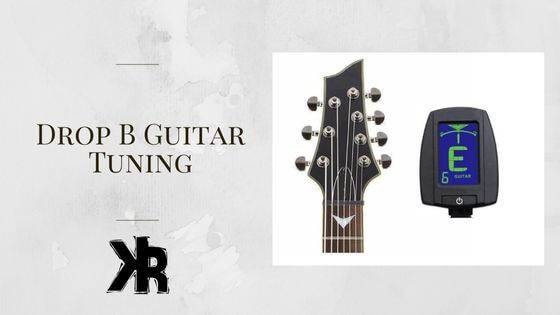Table of Contents
Changing your guitar tuning to Drop B is a great way to get an extra heavy, aggressive sound. This drop tuning is popular among metal and hard rock bands because it gives you that low, growling tone.
This is one alternate tuning that can be rather difficult to pull off with some guitars.
Drop B guitar tuning requires you to tune your instrument down from standard, one and a half steps per string. Then another step on the lowest string down to B. It’s similar to tuning to Drop D but with a deeper pitch.
This Killer Rig article will walk you through the steps of how to tune to drop B. We also have some tips on getting it set up properly.
What Is Drop B Tuning?
Drop B guitar tuning is a type of alternate string pitch arrangement. It’s very popular, especially with 6-string guitars and high-gain power chords. This is because of the deep, low tone that is possible. All without having to go out and get a 7 or 8-string guitar.
Standard guitar tuning is much different. The strings are tuned to the notes E, A, D, G, B, and E. Starting from the lowest pitched string and moving up to the highest.
Drop B tuning is much different. The strings are tuned to B, F#, B, E, G#, and C#. This is with the lowest-pitched string now being tuned to B instead of E.
This lower pitch allows for a heavier, deeper sound. It’s often used in metal and other distorted and aggressive music styles. Not only is it different in pitch, but also playability. The string tension is much lower in drop B tuning. This brings challenges of its own.
How To Tune Your Guitar To Drop B
A guitar tuner or some other reference pitch is highly recommended. You want to ensure that your strings are tuned accurately.
Start by tuning your low E string down to B. This is two and a half steps down from E which is a significant drop.
Further learning: What is a chromatic tuner?
Once the low E is tuned to B, the rest of the strings can be lowered as well. Each of the other strings will only require a drop of one and a half steps. They will then be tuned as follows.
- The fifth or A string should be tuned down to F#.
- Forth or D string tuned down to B.
- Third or G string tuned down one and a half steps to E.
- The second or B string should be tuned down to G#.
- Finally, the high E string should be tuned down one and a half steps to C#.
Proceed slowly when making these changes. You should then have a guitar that is in Drop B tuning. It’s important to remember to tune the strings accurately. Even small differences in pitch can have a big impact on the overall sound of the guitar.
These illustrations will also help you understand Drop B tuning.
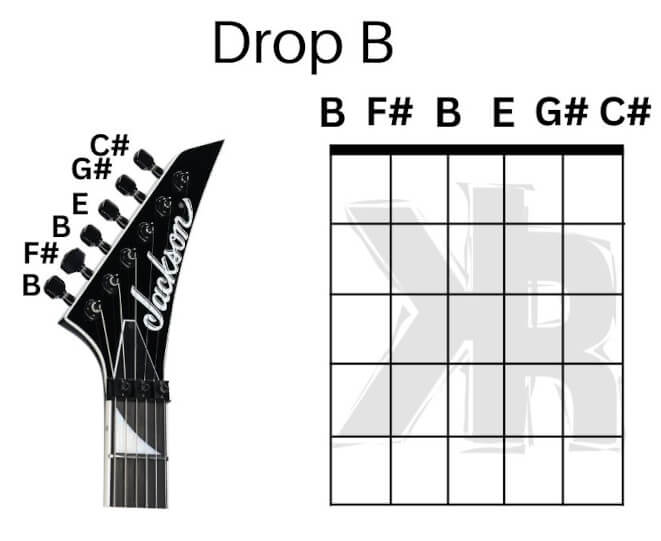
Challenges When Tuning to Drop B
Drop B tuning can present some challenges. Especially with a guitar that has been tuned to standard. This is due to the lower tension of the strings, primarily.
Neck Relief
When the string tension is removed, the neck might begin to lose its bow. As this happens, the strings might begin to buzz against the frets.
It isn’t something that will happen right away. It’s a gradual change as the neck adjusts to the lower tension. This is an issue that can be addressed with a truss rod adjustment.
Playability
You will also notice that because of the lower string tension, they are harder to play. The strings will be very loose. Lighter gauge strings might even be so loose that it’s uncomfortable to play. Personally, I find they are even lifeless and no fun to use.
Dealing With Low String Tension
There are a few different solutions for dealing with low string tension when tuning to Drop B on the guitar. One option is to use heavier gauge strings, which are thicker and provide more tension. This is a great way to prevent neck relief from changing drastically.
Suggested String Thickness
Heavier gauge strings will also make playing the guitar in drop B easier. The added tension improves playability. It also makes the experience more enjoyable, as floppy strings are no fun to try and play.
I suggest you use 12 gauge sets for drop B. But we have an article on string gauge here. Use it to get a better understanding of thickness.
We also suggest that the guitar gets a proper setup. With the large changes that are needed to tune to drop B, the guitar will need some work. Setting up the neck and even having the nut slots widened might be needed.
Playing Your Guitar in Drop B
Once your guitar is set up for Drop B, it can be a lot of fun. It’s great for playing heavier, high gain distorted music styles.
Metal, hardcore, and even punk can become very powerful. But first, you need to know how chords work.
Power Chords
Power chords are a great place to start when playing Drop B. They consist of only the root note. Then, barring three strings. Play them in various positions on the fretboard, and you can create interesting riffs. Once you get to know the notes in drop B.
If you are familiar with drop D then this will be easy to grasp. In drop B, these chords will be even deeper than usual. This adds a lot of weight to your playing. You might try using them in combination with scales to create leads.
Here are a few illustrations to help you with some of the more popular power chords.
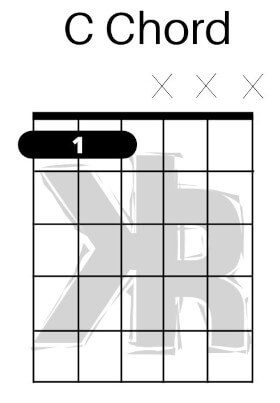
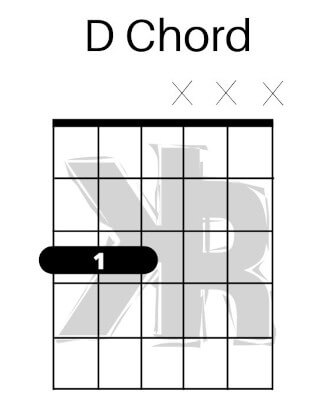
Open Chords
Open chords are a bit more interesting. They are chord shapes that you already might be familiar with from standard tuning.
Yet, when you tune to Drop B they will sound different due to the lower pitch. This also means the note itself is different. Here are a couple examples.
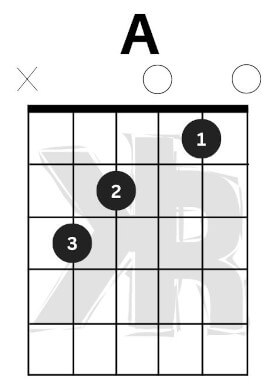
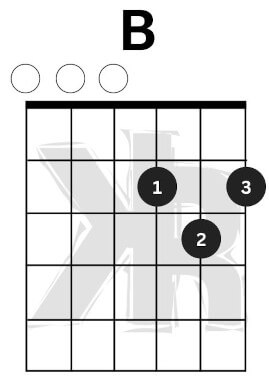
As you can see, a D note in standard is a B when tuned this way. It’s a very good way of getting deep, full chords. You will just need to learn the chord shapes for the new pitch.
But it can be incredibly powerful, especially when you play a B chord. This is one of my favorite sounds when tuned to drop B. It’s incredibly heavy sounding. Especially when used with high-gain amps and thick humbucker pickups!
Learning Scales In Drop B
Another great way to get creative with Drop B tuning is to learn scales. They are a very useful tool when it comes to writing and improvising guitar parts.
In this alternate tuning, you will need to be aware of the new note intervals. Once you learn them, leads and riffs will make more of an impact.
Major Scale
The major scale in Drop B consists of the notes:
- B.
- C#.
- D#.
- E.
- F#.
- G#.
- A# (or B flat).
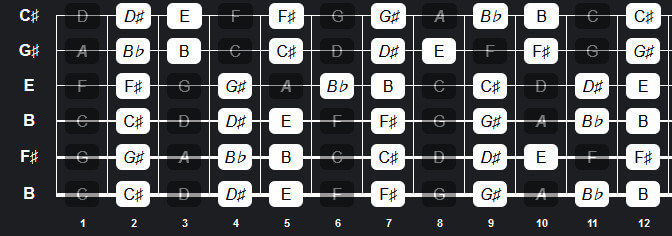
As you can see in the diagram, it uses frets 2, 4, 5, 7, 9, and 11. This is important to know when you are using power chords.
Especially if you want to use this scale for riffs. It’s not as popular for heavier styles of music. Most bands use the minor scale, but it can come in handy. Depending on the music style you play.
Minor Scale
The minor scale in drop B includes the notes:
- B.
- C#.
- D.
- E.
- F#.
- G.
- A.
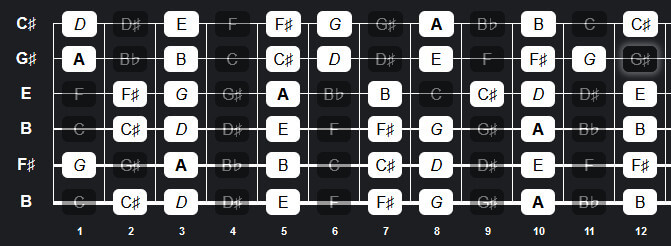
This one uses frets 2, 3, 5, 7, 8, and 10. This scale is a popular choice when it comes to heavy playing styles. There are a lot of bands that use the minor scale in Drop B.
It gives you additional options for melodies that sound heavier and more aggressive. Use the diagram to work on this scale. Memorizing this one will help you play more songs. At least when you are getting started with this drop tuning arrangement.
Make sure to check out our other tuning guides:
Drop B Tuning on 7-String Guitars
The 7-string guitar! A marvel of musical engineering, a testament to the relentless pursuit of sonic diversity. A seventh string, typically tuned to a low B, adds a depth and richness to the guitar’s tonal palette that is nothing short of mesmerizing.
Drop B tuning on a 7-string guitar is akin to adding a subwoofer to a high-fidelity sound system. It brings an extra dimension of depth, a low-end rumble that can shake the foundations of your musical world.
The benefits? A broader tonal range, the ability to play heavier music, and a unique sound that sets you apart from the 6-string crowd.
Tuning a 7-String Guitar to Drop B
So, how does one tune a 7-string guitar to Drop B? It’s a dance of precision, a delicate balancing act. The lowest string (B) remains as it is.
The next six strings are tuned differently than the 6-string guitar in Drop B. So you end up with B, F#, B, E, G#, C#, F#. The result? A guitar tuned for heavy, aggressive soundscapes, ready to roar with the slightest touch.
Who Uses Drop B Tuning?
If you are looking for more songs or something that you might like better, here are bands that use Drop B tuning!
- August Burns Red.
- Linkin Park.
- Bring Me The Horizon.
- Elitist.
- Mudvayne.
- Parkway Drive.
- Motionless In White.
Most of these bands use Drop B and have a catalog of other songs. They are pretty easy to find and a lot of fun! Experiment until you have Drop B mastered.
Extra Tips To Help You Succeed in Drop B
Overall, drop B tuning can be a great way to get creative with your guitar playing. The deeper tones provide more impact. You can use this to your advantage when writing riffs or soloing. Here are some tips that will help you succeed when starting with this tuning:
- Make sure your guitar is set up to perform well in drop B.
- Increase your string thickness for better playability.
- Familiarize yourself with the new root notes in drop B.
- Learn the scales that are available in this tuning to use for leads as well as chords.
- Take some time to learn a few songs. This will help you get familiar with the new notes.
- Experiment with different picks to find new sounds. Thicker picks sound different from thin ones.
- Take your time and be patient. Learning anything new takes time.
Songs In Drop B
Many music styles can benefit from drop B. The deep, low tone is very musical. You will find that a majority of heavier bands use this tuning.
If you prefer heavier music, then here are a few songs that you can start playing. This will help you get familiar with the new guitar tuning.
Slipknot – Duality
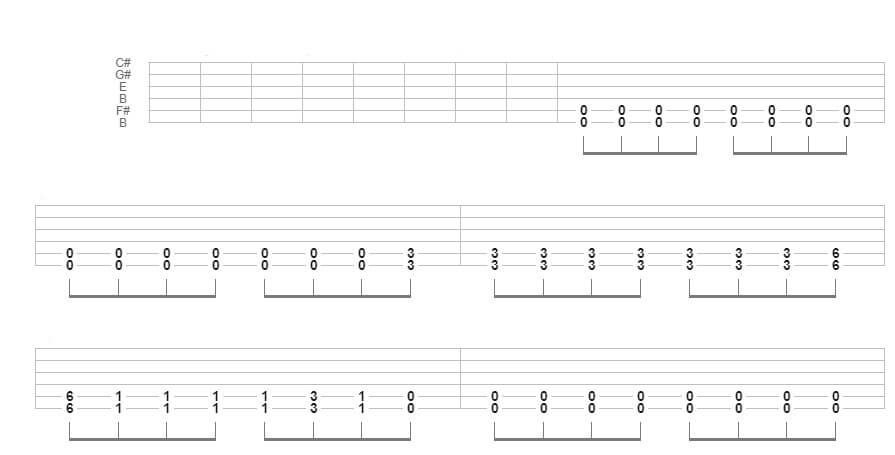
No list of heavy sounds would be complete without Slipknot. Their song Duality is a popular drop-B tune.
Most of their songs are drop B, so we chose this one to start off with. It’s a heavy-sounding song with a tight low end and palm muting.
If you need the tablature, you can find them here.
Chevelle – Send The Pain Below
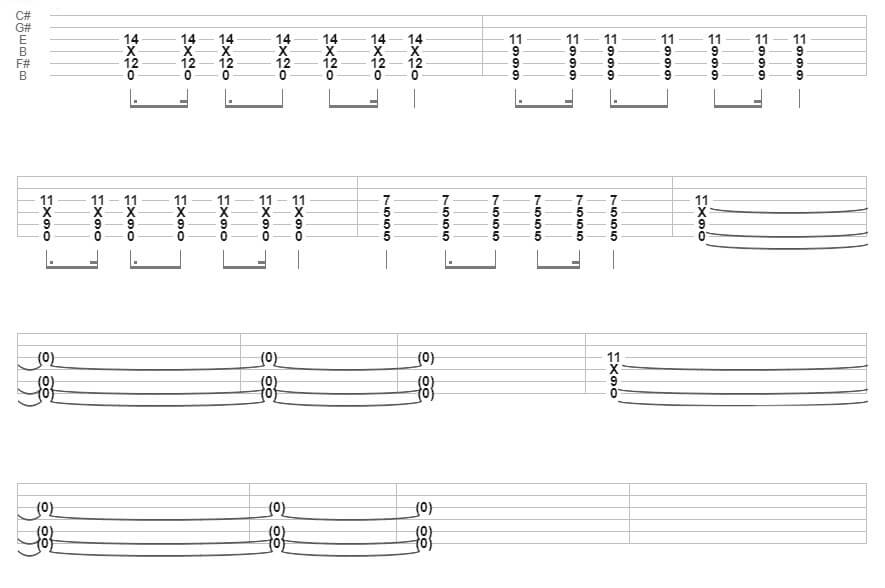
This is a great one to learn. It’s not as heavy sounding as the above tune, but the chorus section is definitely worth trying out. It has a thick sound as it uses power chords in all the right places.
Again, you might need some tabs for this one if you are having trouble finding the right notes. You can find them here.
Architects – Buried At Sea
Architects have some great songs. This one is very technical, and it’s a good way to challenge your guitar-playing skills. The song has a lot of fast parts, so you will want to practice the scales before attempting this one.
Here are the tabs if you need a bit of help.
Conclusion
Dialing down to Drop B tuning on your guitar, you unlock a whole new universe of deep, rich tones. With a good grasp on scales and tunes in this tuning, your guitar playing might just leap a notch up.
Drop B isn’t everyone’s cup of tea. But, hey, you won’t know until you give it a shot, right?
And remember, variety’s the spice of life. Don’t just stick to what you know. Tinker around, try new styles, new methods. That’s how you squeeze every last drop of goodness out of this tuning.

